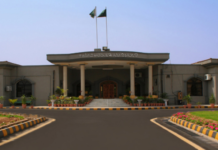DM Monitoring
BAKU: Azerbaijan said on Sunday that Armenian armed forces had shelled its second city of Ganja in a major new escalation of the conflict in the South Caucasus.
Armenia denied that it fired towards Azerbaijan, but the leader of Nagorno-Karabakh, an ethnic Armenian enclave inside Azerbaijan, said his forces had destroyed a military airbase located in Ganja.
“Permanent military units located in the large cities of Azerbaijan from now on become the targets of the defence army,” said Karabakh leader Arayik Harutyunyan.
The Azeri defence ministry said the cities of Terter and Horadiz near the de-facto border with Nagorno-Karabakh were under heavy shelling, while the breakaway region’s military said its capital, Stepanakert, was under bombardment.
The fighting began a week ago and has surged to its worst level since the 1990s, when some 30,000 people were killed.
The conflict risks dragging in other regional powers such as Russia and Turkey and disrupting energy supplies via the South Caucasus, where pipelines carry Azeri oil and gas to world markets.
Meanwhile, Armenia said on Saturday it would use “all necessary means” to protect ethnic Armenians from attack by Azerbaijan, which said its forces had captured a string of villages in fighting over the mountain enclave of Nagorno-Karabakh.
Ignoring a French attempt to mediate, the opposing sides pounded each other with rockets and missiles for a seventh day in the newest flare-up of a decades-old conflict that threatens to draw in Russia and Turkey.
The death toll rose to at least 230 in the fighting over Nagorno-Karabakh, an ethnic Armenian enclave inside Azerbaijan that broke away from its control in the 1990s.
Each side said it had destroyed hundreds of the other’s tanks. The Azeri side claimed gains, and President Ilham Aliyev sent congratulations to a military commander on the capture of a Karabakh village. “Today the Azeri army raised the flag of Azerbaijan in Madagiz. Madagiz is ours,” Aliyev declared on social media. He later announced the capture of seven more villages. Hundreds of people took to the streets of the Azeri capital Baku in celebration, waving flags and placards reading “Karabakh was and will be ours”.
It was not possible to independently verify the situation on the ground. Armenian Defence Ministry official Artsrun Hovhannisyan said the situation was changing frequently. “In such a large war such changes are natural. We can take a position, then leave it in an hour,” he told reporters. Armenian Prime Minister Nikol Pashinyan told his countrymen in a televised address that fighting all along the front was intense.
“As of now, we already have significant human losses, both military and civilian, large quantities of military equipment are no longer usable, but the adversary still has not been able to solve any of its strategic issues,” he said.
Armenia’s armed forces have so far held back from entering the war alongside those of Nagorno-Karabakh. But Pashinyan portrayed the conflict as a national struggle and compared it to the country’s war with Ottoman Turkey in the early 20th century.
His Foreign Ministry said Armenia, as the guarantor of Nagorno-Karabakh’s security, would take “all the necessary means and steps” to prevent what it called “mass atrocities” by the forces of Azerbaijan and its ally Turkey. A ministry spokeswoman declined to comment on what steps this could entail.
The clashes are the worst since the 1990s, when some 30,000 people were killed. They have raised international concern about stability in the South Caucasus, where pipelines carry Azeri oil and gas to world markets.
Apart from a four-day war in 2016 that killed about 200 people, the Karabakh region has mostly been calm for the past quarter-century, with Russia playing a balancing role as an ally of both Armenia and Azerbaijan.
Now Azerbaijan, emboldened by Turkish backing, says it has run out of patience with decades of ineffective diplomacy that have failed to lead to the return of its lost territory.



